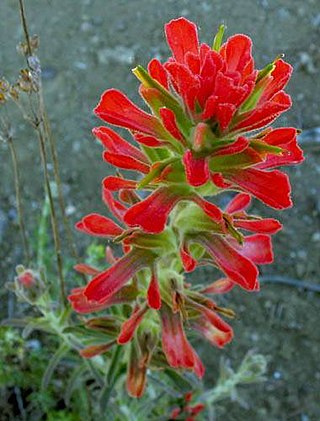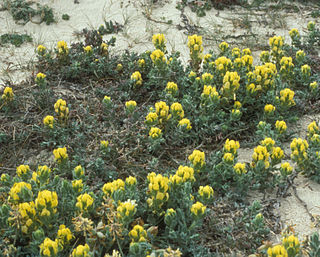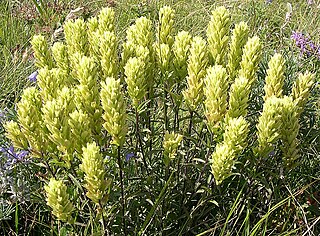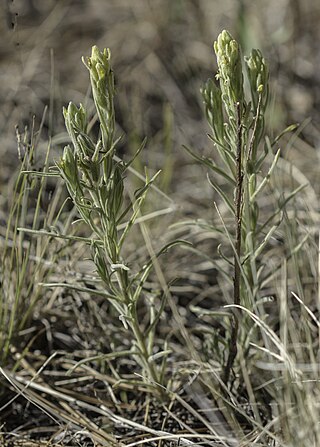
Lepechinia fragrans is a flowering herbaceous shrub known by the common names island pitchersage and fragrant pitchersage. It is a member of the Lamiaceae, or mint family, but like other Lepechinia, the flowers are borne in racemes instead of in mintlike whorls.

The Tiburon paintbrush or Tiburon Indian paintbrush is an endangered taxon of flowering plant in the family Orobanchaceae. It is endemic to the San Francisco Bay Area in California in the United States, where it occurs in Marin, Napa, and Santa Clara Counties.

Pedicularis groenlandica is a showy flowering plant in the family Orobanchaceae commonly known as elephant's head, little pink elephant, elephantella, or similar common names inspired by the resemblance of the flower to the head of an elephant. It is also less commonly known as butterfly tongue for the long beak on the flower. Like many other plants in genus Pedicularis, it is a parasitic plant and depends on host plants to survive.

Castilleja densiflora is a herbaceous flowering plant species known by the common names denseflower Indian paintbrush or white / denseflower owlclover. Like other members of the Indian paintbrushes, it is a root-parasite. It is native to California and northern Baja California, where it grows in grassland and chaparral habitat. It is a variable species. It is generally 10 to 40 centimeters tall with linear or lance-shaped leaves up to 8 centimeters long, and with or without lobes. The inflorescence is as small as 3 centimeters or as long as 25 centimeters in length, and has bracts tipped in white to dull or bright pink or purple. Between the bracts appear the flowers, which are somewhat rounded and pouched, and white to yellow to pink or purple in color.

Castilleja foliolosa is a species of Indian paintbrush, known by the common names woolly Indian paintbrush and Texas Indian paintbrush.

Castilleja miniata is a species of Indian paintbrush known by the common name giant red Indian paintbrush. It is native to western North America from Alaska to Ontario to California to New Mexico, where it grows usually in moist places in a wide variety of habitat types.

Castilleja mollis is a species of Indian paintbrush known by the common name softleaf Indian paintbrush. It is endemic to the Channel Islands of California, where it is currently known only from Santa Rosa Island. An occurrence was once noted on San Miguel Island, but the plant has not been found there since 1938. Its habitat is the coastal sage scrub around the windy sand dunes and bluffs.

Castilleja parviflora is a species of Indian paintbrush known by the common name mountain Indian paintbrush. It is native to western North America from Alaska to California, where it grows in high mountain habitat, including areas of alpine climate.

Castilleja occidentalis is a member of the genus Castilleja (paintbrush), commonly referred to as western Indian paintbrush. Like other members, it is a hemi-parasite.

Penstemon grandiflorus, known by the common names shell-leaved penstemon, shell-leaf beardtongue, or large-flowered penstemon, is a tall and showy plant in the Penstemon genus from the plains of North America. Due to its large flowers it has found a place in gardens, particularly ones aimed at low water usage like xeriscape gardens.

Castilleja kaibabensis is a species of flowering plant in the family Orobanchaceae known by the common name Kaibab Plateau Indian paintbrush. It is endemic to the Kaibab Plateau of Coconino County, Arizona, in the United States.

Castilleja coccinea, commonly known as scarlet Indian paintbrush or scarlet painted-cup, is a biennial flowering plant in the Orobanchaceae (broomrape) family. It is usually found in prairies, rocky glades, moist and open woodlands, thickets, and along streams in central and eastern North America.

Castilleja integra, with the common names orange paintbrush, Southwestern paintbrush, and wholeleaf paintbrush, is a partially parasitic herbaceous perennial plant native to the Southwestern United States and Northern Mexico. The species produces a relatively large amount of nectar and is attractive to hummingbirds. It is better suited to cultivation than most other species in the paintbrush genus (Castilleja) and is therefor used in xeriscape gardens and naturalistic meadows, even outside its native range.
Castilleja kerryana is a species of flowering plant in the family Orobanchaceae. It is commonly known as Kerry's Indian paintbrush or Kerry’spaintbrush. It was formally described in 2013 and so far it is known only from a small population in the state of Montana, in the Northwestern United States.

Salix argyracea is a large shrub from the genus of willow (Salix) with up to 10 centimeters long leaf blades with a felty hairy and shiny underside. The natural range of the species is in Kazakhstan, Kyrgyzstan, and China.

Castilleja elmeri is a species of flowering plant in the family Orobanchaceae with the common name Elmer's paintbrush. As with most Castilleja species, this is a facultative root hemiparasite and will usually be seen growing close to a host plant.

Castilleja thompsonii is a species of hemiparasitic perennial herb in the Orobanchaceae family with the common name Thompson's Indian paintbrush. It is native to south central British Columbia and Washington State.

Lupinus caudatus is a widespread species of wildflower in genus Lupinus from western North America known by the common names tailcup lupin and spurred lupin. It is distinctive for the short spur on its purple-blue flowers, for which it is named. Because of its wide distribution and toxicity it commonly causes poisonings of susceptible livestock such as horses, cattle, and sheep, though it is eaten without harm by wild herbivores like deer and elk. It is generally found from the Coastal Ranges and Sierra Nevada Mountains in the west to the Rocky Mountains in the east.

Castilleja rhexiifolia, commonly called rosy paintbrush, subalpine paintbrush, or rhexia-leaved paintbrush, is a species of plant in Orobanchaceae, commonly known as the broomrape family. They are a common flower found in moist habitats near or above timberline in the Rocky Mountains and the Pacific Northwest. Like most members of the Castilleja genus, they are partially parasitic plants.

Castilleja lineata, commonly known as marshmeadow paintbrush or linearlobe paintbrush, is an uncommon species that largely grows in the mountains of northern New Mexico, but is also found in small areas of neighboring Colorado and Arizona. It was not scientifically described until 1901 and is little studied.






















